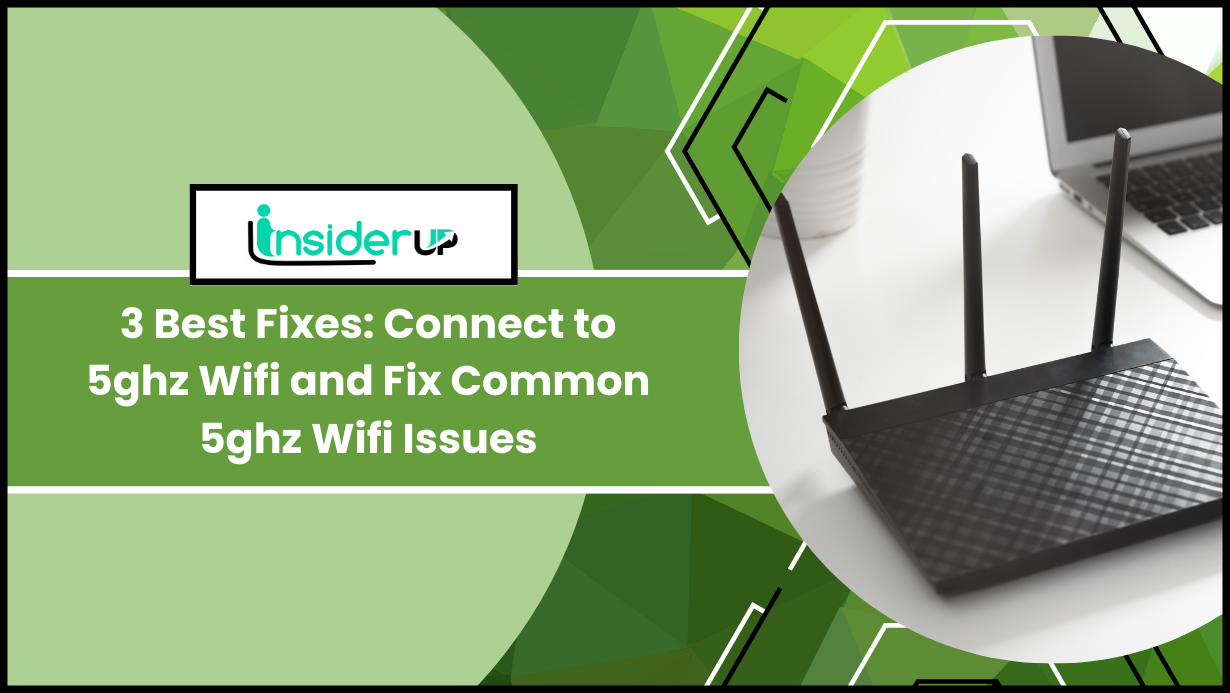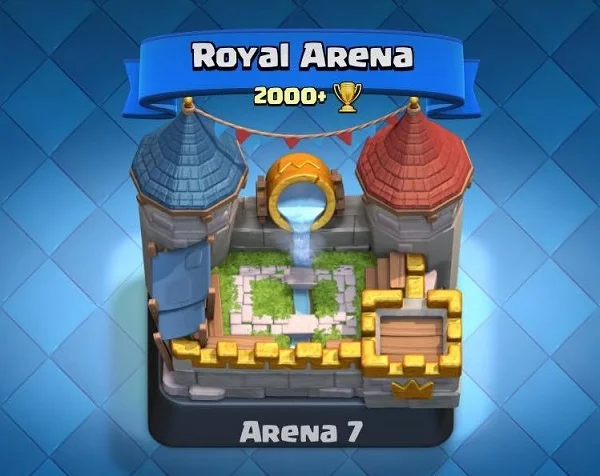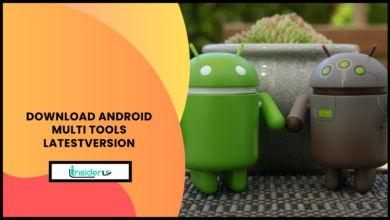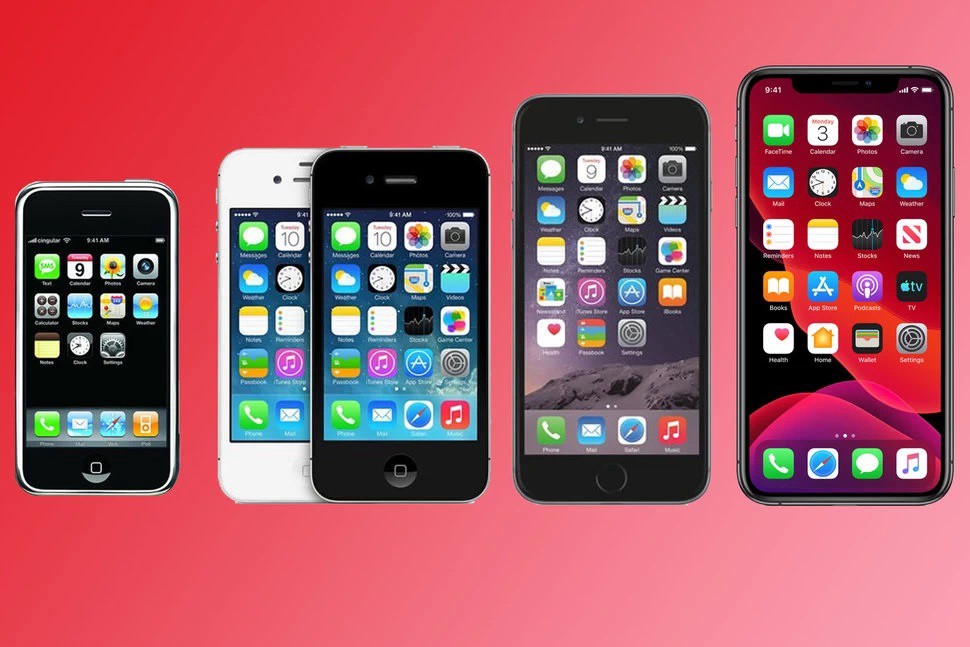
Since its initial release in 2007, the iPhone has revolutionized the smartphone industry and become an iconic technology product recognized across the globe. Examining the evolution of the iPhone throughout its various generations reveals how Apple has consistently pushed innovations while retaining familiar elements. Let’s explore a complete history of iPhone releases in chronological order, witnessing firsthand how the device has transformed over time with regards to design, performance, camera technology, software features and more.
When Steve Jobs first unveiled the original iPhone in January 2007 after years of rumors and speculation, he introduced it as a combination of three products: “a widescreen iPod with touch controls, a revolutionary mobile phone and a breakthrough internet communications device.” This inaugural iPhone model is now called the iPhone 2G following the numerical naming convention. Released on June 29, 2007, the iPhone 2G sported a 3.5 inch LCD screen, 2MP rear camera, 4/8GB storage options, and was powered by an ARM-based processor. It popularized new concepts like multi-touch gestures on a smartphone and introduced the groundbreaking iOS software with features like visual voicemail integrated with one fluid interface. Next came 2008’s iPhone 3G with 3G network support for faster data speeds which was accompanied by the launch of the revolutionary App Store. This ability to add new software experiences is a key pillar contributing to the iPhone’s wild success over 15+ years now.
Every year since, Apple has gone on to release new iPhone models. 2009 brought the iPhone 3GS which doubled Ram and added video recording. 2010 then unveiled a major redesign with the iPhone 4 and its signature “retina” display and front facing “FaceTime” camera. This kicked off an alternating “tick-tock” release cadence where design overhauls (iPhone 4, iPhone 5, iPhone 6) were followed by “S model” upgrades (4s, 5s) for several generations. In between were also factors like new materials like glass and aluminum to replace plastic casings, changes to screen sizes like 2014’s iPhone 6 and 6 Plus’s bigger displays or the 2017 advent of the notched screen design with iPhone X.
Now well into its second decade of iPhones, we’ve witnessed everything from 2018’s iPhone XR delivering more affordable price points, to multiple camera lenses for optical zoom capabilities and advanced photographic techniques in the iPhone 11 Pro, to industrial design changes like removing the iconic home button. Newer iPhone 13 models even adopted an adaptive 120Hz screen refresh rate for smoother visuals. Apple has supported iPhones with software updates delivering new features for generally 5-6 years after initial release which is industry-leading. This translates to getting up to 8 major iOS software updates on a single iPhone encouraging sustainable long-term ownership.
Over 15 years, iPhone displays have also steadily increased in quality from the original iPhone’s 163ppi resolution up to the iPhone 14 Pro’s world class ~460ppi pixel density with up to 2000 nits peak HDR brightness. The current A16 chip outperforms the original iPhone’s processor by nearly 100x for immense computing gains. iOS has evolved from a blank slate into a robust, feature-packed operating system with extensive accessibility options cementing it as an industry leader. With over 2.65 billion iPhones sold to date, it’s clear these strategies resonate worldwide.
In examining the complete timeline of iPhone launches since 2007 cataloguing all iPhone models year-by-year, we see how Apple’s willingness to buck trends and take bold risks pays dividends. As we look ahead, rumors suggest a completely portless iPhone design could be coming within a few years as Apple forges the next era of the iconic handheld computer it first introduced with that memorable black and aluminum form factor back on January 9th, 2007. Until then, we can reminisce and admire the historic technological evolution embodied in these devices. Tracking the iPhone’s journey from original to contemporary form unveils how transformative Apple’s innovations become mainstream over time.
From 2007 till 2023, here’s a complete list of all iPhones, sorted by release date.
The History of iPhones from Original to Latest Models
Here is the lineage of all iPhone models released between 2007 to 2023, ordered chronologically by launch date:
2007 – iPhone (1st Gen)

- 3.5″ display
- 2MP camera
- 4/8GB storage
- Original iPhone OS software
- No App Store yet
- Review: Groundbreaking touchscreen smartphone but lacked key features like app support and 3G connectivity.
The revolutionary first iPhone introduced in 2007 featured a 3.5-inch LCD touchscreen display, 4/8GB storage options, a 2MP rear camera, and Apple’s new iOS operating system. It was powered by a 412 MHz single-core processor paired with 128MB RAM.
Key software features included multi-touch gestures, web browsing over WiFi and 2G networks, iTunes syncing and the first appearance of core apps like Phone, Mail, Safari and more.
The original iPhone set the blueprint for the modern smartphone with its large capacitive touchscreen and software capabilities like pinch-to-zoom webpages. It upended the mobile industry and began Apple’s ascent.
2008 – iPhone 3G
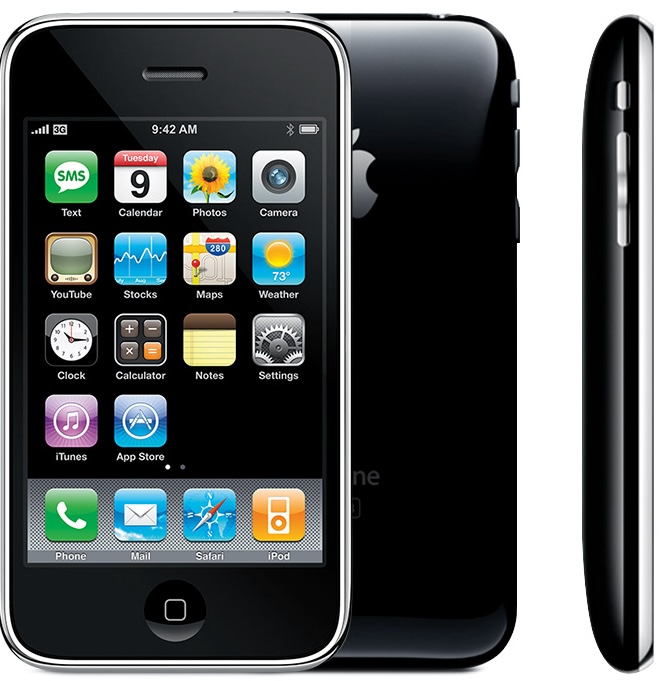
- Faster 3G wireless connectivity
- Assisted GPS navigation
- App Store introduced
- 8/16GB storage options
- 2MP camera unchanged
- Plastic back design
- First model in black and white
- Review: The addition of 3G and the App Store made this a worthy upgrade.
Arriving a year later, the iPhone 3G maintained the original model’s design but added faster 3G network support through HSDPA.
It also introduced App Store giving users access to 3rd party apps, offered assistance from GPS satellites, provided a white and black color option, and delivered hardware additions like a flush mounted audio jack and better speakers and battery. The iPhone 3G also shipped with the new iOS 2.0.
2009 – iPhone 3GS
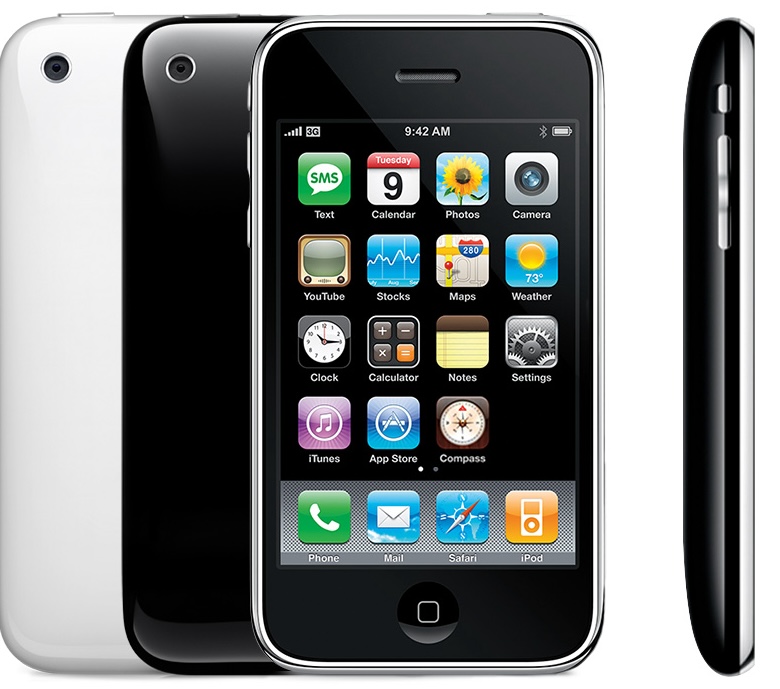
- Speedier processor
- 3MP camera with video recording
- Compass app introduced
- 32GB max storage
- Voice control added
- Longer battery life
- iOS 3 brought spotlight search
- Review:Video recording and voice controls enhanced the experience but design unchanged.
The iPhone 3GS went on sale in 2009 with the “S” representing speed. It focused on internal upgrades like boosting the processor to 600 MHz, including 256MB RAM, and adding a compass and voice control features.
The rear camera increased to 3MP with support for recording video, while the storage capacity reached 32GB.
Externally identical to the 3G, the iPhone 3GS ran iOS 3.0 which fleshed out spotlight search functionality. It targeted improved overall performance.
2010 – iPhone 4
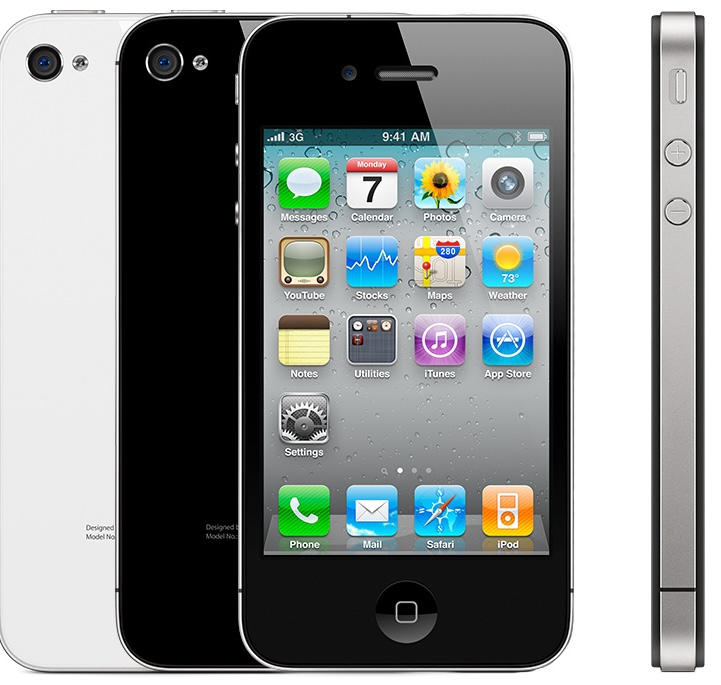
- New sleek glass and steel design
- ‘Retina’ high resolution display
- Front facing camera for selfies and FaceTime
- Rear camera improved to 5MP with LED flash
- HD 720p video recording
- iOS 4 with multitasking
- First model with 16/32GB storage tiers
- Review: Stunning new industrial design and camera improvements made this a standout.
The iPhone 4 represented one of Apple’s most striking iPhone redesigns ever with an all-new flat-sided frame constructed of metal and glass.
It introduced Apple’s high resolution “Retina Display” with a formerly unprecedented 326 pixels per inch for incredible sharpness.
Major upgrades came to the rear camera which jumped to 5MP, could record 720p HD video, and was supplemented by a front facing camera for video calls through the new FaceTime app.
Power also improved with Apple’s A4 chip including a GPU core for enhanced graphics capabilities. Connectivity advances included a new external antenna system for improved reception and adoption of the 802.11 n WiFi standard promising faster speeds.
2011 – iPhone 4S

- Dual-core A5 processor boosted speed
- Siri voice assistant debuts
- Rear camera upgraded to 8MP with better low light shots
- Unveiled iCloud storage
- Last model with small 3.5” display
- Review: Not a major overhaul but brought useful additions like Siri and iCloud.
2011’s iPhone 4S focused more on internal enhancements versus external changes. Continuing the previous model’s design and display, key improvements included a new dual-core Apple A5 processor chip doubling CPU potential and boosting graphics up to 7x over the iPhone 4.
Storage options ramped up to 64GB maximum, while the rear camera grew to 8MP adding 1080p full HD video recording and other imaging features.
Arguably the biggest addition was Siri – Apple’s new virtual assistant technology that could respond to natural voice commands to make calls, play music, provide info and more. Available in black and white, the 4S emphasized under-the-hood advances.
2012 – iPhone 5
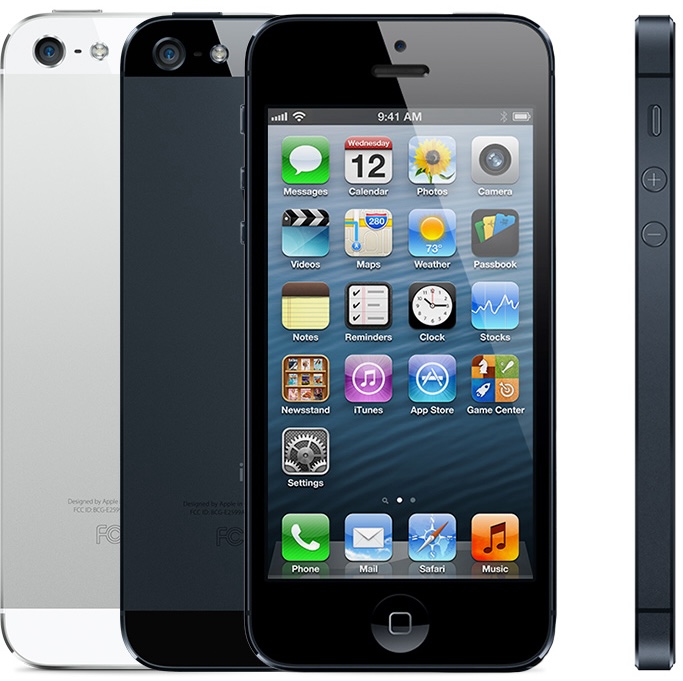
- First 4” display (1136×640 resolution)
- Sleek aluminum unibody design
- LTE connectivity
- Lightning port introduced
- Panorama mode added to 8MP iSight camera
- Three storage tiers: 16/32/64GB
- Review: Screen size bump and LTE speeds made this a significant upgrade.
Apple refreshed the iPhone design with the 2012 iPhone 5 model which was taller yet thinner than its predecessor and featured an aluminum unibody with metal diamond cut chamfered edges. It weighed only 112 grams despite a larger 4-inch display.
LTE wireless offered data access up to 10 times faster where supported. Hardware gains included a speedy new A6 processor, improved cameras with face detection and HD video stabilization, as well as three separate microphones for noise reduction capabilities.
The famous 30 pin charging port also got replaced by the new reversible Lightning connector introduced on this iPhone version.
2013 – iPhone 5c
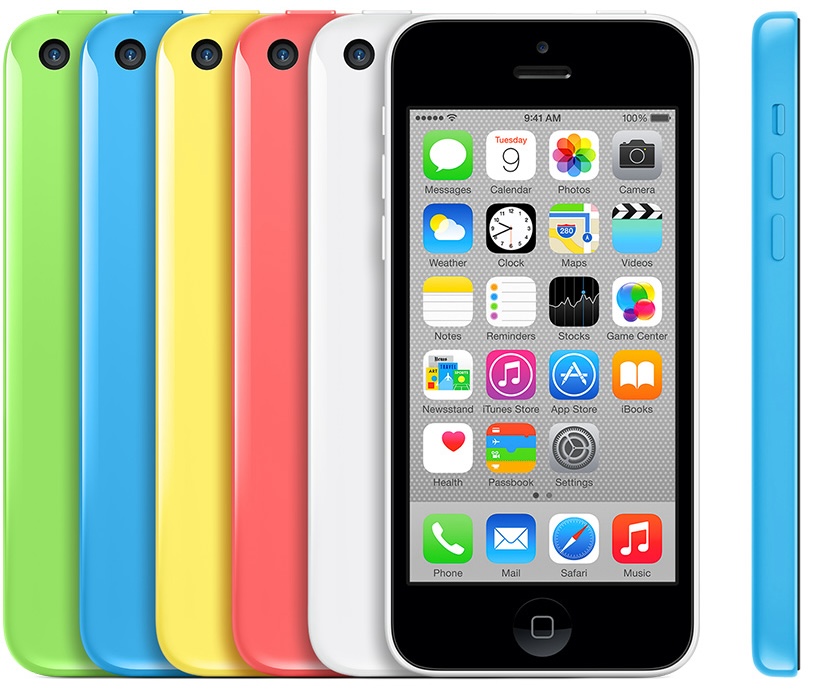
- Release Year: 2013
- Display: 4-inch Retina display with 1136×640 resolution
- Storage Options: 16GB or 32GB
- Chip: Apple A6 chip
- Rear Camera: 8MP
- Front Camera: 1.2MP FaceTime HD camera
- Battery Life: Up to 10 hours talk time, 10 hours internet use (LTE), 8 hours on WiFi, 10 hours video playback
- Charging: Lightning connector, no wireless charging
- Size and Weight: 124.4 x 59.2 x 8.97 mm, 132 grams
- Design: Colorful plastic body available in blue, green, pink, yellow, white
- Operating System: iOS 7
- Special Features: 4G LTE connectivity
The iPhone 5c debuted in 2013 as Apple’s first lower-cost, mass appeal iPhone without fully cutting corners.
It retained preceding iPhone 5 internal specifications like the A6 chip, 4-inch display, and 8MP rear camera, but encased them in a uniquely colorful, curved polycarbonate body.
Hoping to address developing markets where cost played a bigger role than cutting edge features, it started at just $99 on contract.
The iPhone 5c came in a suite of bright finishes like blue, pink, green, yellow and white that would stand out from previous iPhones. While not distinctly advancing technology, the 5c’s strategy expanded iPhone’s reach.
2013 – iPhone 5S
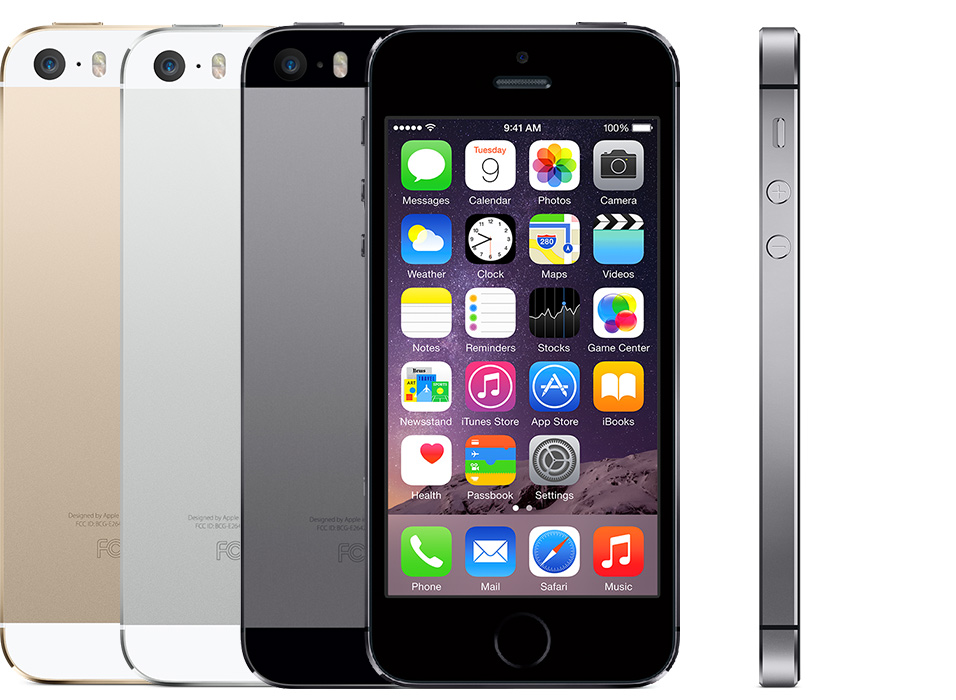
- Touch ID fingerprint unlocking introduced
- Powerful new 64-bit A7 processor
- M7 motion coprocessor for fitness tracking
- Improved 8MP rear camera with slow-mo 120fps video
- Gold color option added
- iOS 7 overhaul with new flat icon design
- Review: Touch ID, the 64-bit chip, and camera boosts made for an “S” model done right.
Announced concurrently, the flagship iPhone 5s in 2013 concentrated on novel functionality versus superficial changes.
Continuing the anodized aluminum and glass build of the iPhone 5, pioneering features were added like the Touch ID fingerprint scanner for quickly unlocking the phone without passcodes.
Built using Apple’s first 64-bit architecture, the A7 processor promised twice the computing power and graphics as the prior A6 chip.
A motion data coprocessor managed measurements from the accelerometer, gyroscope and compass while demanding minimal battery.
A significantly enhanced 8MP iSight camera enabled slow motion 120fps video. The iPhone 5s ambitiously augmented capabilities.
2014 – iPhone 6 / 6 Plus
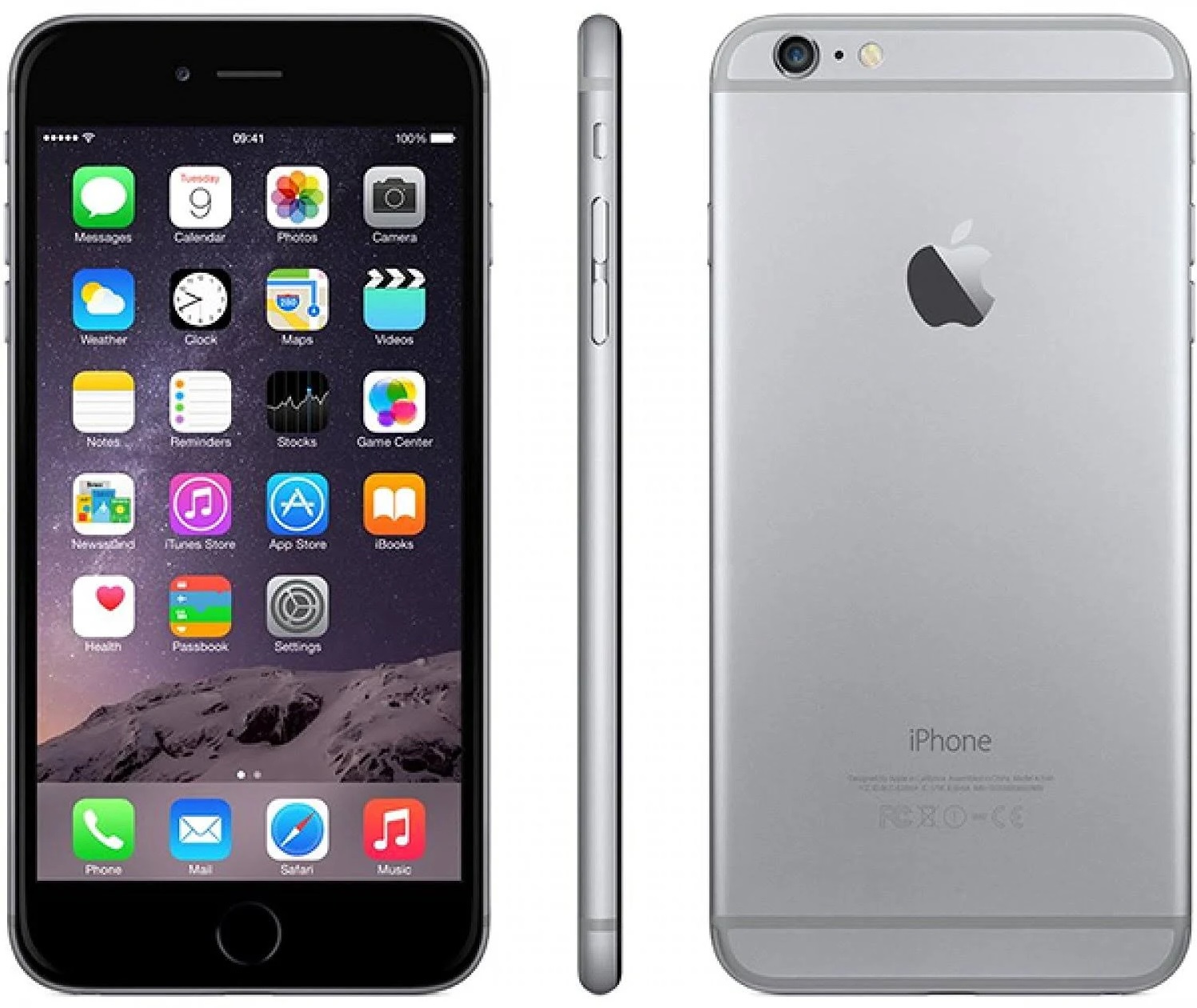
- First 4.7” and 5.5” iPhone models
- Higher resolution “Retina HD” displays
- NFC chip for Apple Pay mobile payments
- Protruding rear camera lens
- Optical image stabilization added
- Faster A8 processor and M8 motion coprocessor
- Review: Bigger screens and Apple Pay put the iPhone back in front.
The iPhone 6 was released in September 2014. It featured a 4.7 inch 1334×750 retina HD display, an Apple A8 chipset, and an 8MP iSight camera. Major new features included Apple Pay support through NFC, faster LTE connectivity, and improved cameras over the iPhone 5s. The industrial design was thinner than previous models at 6.9mm and had curved edges for a smooth feel in the hand. It proved to be an exceptionally popular model for Apple.
The iPhone 6 Plus was unveiled alongside the iPhone 6 as Apple’s first phablet iPhone with a huge 5.5 inch 1920×1080 retina HD display. It shared the same internal specs like Apple’s A8 chip but differentiated itself through optical image stabilization in the camera and a larger battery for increased usage time between charges. The bigger screen allowed the 6 Plus to utilize a landscape mode for certain apps. While more unwieldy than the 6, the 6 Plus appealed to those wanting as much screen real estate as possible on their iPhone. It spawned a trend toward bigger screens that continues with current iPhone models.
2015 – iPhone 6S / 6S Plus
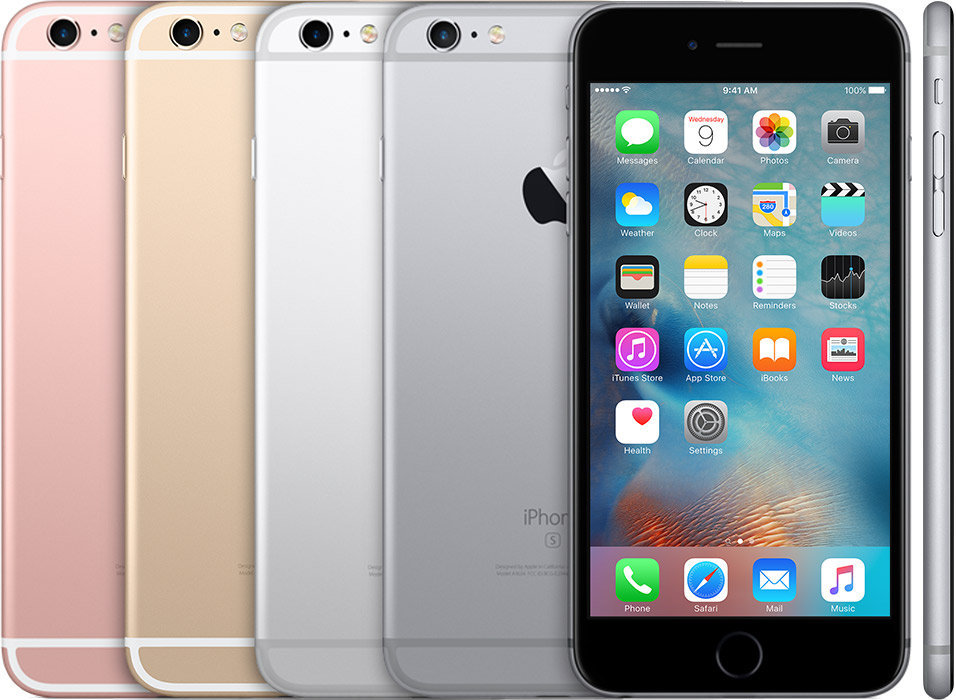
- 3D Touch pressure sensitive display
- A9 chipboosted performance further
- 12MP iSight camera shoots 4K video
- Selfie camera updated to 5MP with Retina Flash
- Rose gold color option
- Review: Not a major overhaul but 3D Touch and improved cameras made it compelling.
The iPhone 6s and 6s Plus evolved the brand new design of the iPhone 6 series. Key additions included a strengthened 7000 series aluminum body, new rose gold color option, upgraded 12MP iSight camera for 4K video and Live Photos, as well as faster Touch ID.
The models also introduced Apple’s Taptic Engine providing tactile feedback and 3D Touch displays detecting pressure for new interface interactions. Under the hood, Apple’s new A9 chip offered 70% faster CPU and 90% better graphics performance.
2015 – iPhone SE

- Display: 4.7-inch Retina HD display (1334 x 750 resolution)
- Chip: A13 Bionic chip with third-generation Neural Engine
- Camera: Single 12MP wide camera with f/1.8 aperture; 7MP FaceTime HD front camera
- Memory and Storage: 3GB RAM; 64GB, 128GB, or 256GB storage options
- Connectivity: Wi-Fi 6, 5G, Bluetooth 5.0, NFC, Lightning connector
- Biometric Authentication: Touch ID fingerprint sensor (no Face ID)
- Battery Life: Up to 13 hours of video playback
- Water Resistance: IP67 rated for dust and water resistance up to 1 meter for 30 mins
- Dimensions and Weight: 138.4 x 67.3 x 7.3mm; 5.22 ounces
- Colors: Black, White, Product RED Other
- Features: Wireless charging support, stereo speakers, iOS 15 and later support
The original iPhone SE was released by Apple in March 2016 as a compact, mid-range iPhone option. Sporting a sleek, aluminum unibody design with chamfered edges, the iPhone SE reused the classic 4-inch form factor of the iPhone 5s from 2013 while upgrading internal components.
It was powered by Apple’s newest A9 chip and M9 motion co-processor at the time for performance rivaling the flagship iPhone 6s. The rear 12MP camera also matched the 6s, which was impressive in the smaller SE body.
Other features like Apple Pay, Touch ID, 4K video recording and Live Photos made the iPhone SE feel modern. Its small size struck a chord with fans of older iPhones, while the $399 starting price made it an affordable option without compromising on Apple’s renowned hardware and software capabilities.
At just over 4 inches tall, under 2 inches wide and 0.28 inches thin, the compact SE fit nicely in pockets and hands alike. While the original iPhone SE lacked 3D Touch and higher resolution screens of newer iPhones, it delivered a powerful, pint-sized punch at the right price for millions of customers.
2016 – iPhone 7 / 7 Plus


- First iPhone with IP67 water resistance
- Controversial removal of 3.5mm headphone jack
- Dual 12MP cameras on Plus with Portrait mode
- Stereo speakers on both models
- Jet Black color introduced
- Review: Losing the headphone jack upset some but the Plus model’s dual cameras wowed.
With the iPhone 7 series in 2016, Apple solidified the external design first seen in 2014’s iPhone 6 while making key internal enhancements.
Upgrades included IP67 water and dust resistance, boosting battery life to around 2 hours longer than iPhone 6s models, quad-core processors on Plus variants, and cameras with optical image stabilization.
Controversially, Apple removed the 3.5mm headphone jack to push for wireless audio use, but included an adapter in box. New Black, Jet Black and Red special edition colors joined the lineup.
2017 – iPhone 8 / 8 Plus


- Glass back design enabled wireless charging
- More power efficient A11 Bionic processor
- True Tone display adjusted white balance
- Portrait Lighting added depth effects to portraits
- Augmented reality capabilities debuted
- Review: Wireless charging and camera tweaks made for a modest but worthwhile “S” upgrade.
2017’s iPhones 8 and 8 Plus focused on high performance and wireless charging support in package very similar to the iPhone 7 generation.
Internally they featured Apple’s first six-core processors for substantial speed gains and dedicated Neural Engine hardware for advanced machine learning capabilities.
Glass backs enabled the new fast charging and wireless charging through Qi mats. True Tone displays adapted white balance to ambient lighting while cameras had improved sensors and Portrait Lighting effects. The 8/8 Plus series brought significant refinements if an unchanged design.
2017 – iPhone X

- Radical redesign with no home button and nearly all-screen front
- Edge-to-edge 5.8” OLED Super Retina display
- Face ID facial recognition unlocking
- Vertical dual rear cameras with Portrait mode improvements
- Animated emojis introduced
- Review: The futuristic iPhone X introduced multiple innovations like Face ID and the notch.
The iPhone X introduced a radical redesign featuring an edge-to-edge 5.8-inch OLED display with no home button.
It removed Touch ID in favor of Face ID facial recognition powered by a TrueDepth camera and sensor array. The glass and stainless steel body brought wireless charging, while the A11 Bionic chip and neural engine boosted speed and AI capabilities.
iPhone X also offered upgraded dual cameras, and introduced Animoji embedding users’ motions onto animated emoji characters via the front camera. Despite a $999 starting price, iPhone X showcased Apple’s vision for the smartphone future.
2018 – iPhone XS / XS Max

- 5.8” and massive 6.5” OLED displays
- A12 Bionic chip further enhanced speed and efficiency
- Upgraded 12MP dual cameras on back with Smart HDR
- Gold stainless steel design
- 512GB storage option added
- Review: The powerful A12 processor and improved cameras made this a substantial upgrade.
As the successors to the redesigned iPhone X, the XS and XS Max focused on performance upgrades while maintaining the core bezel-less aesthetic.
Improvements included Apple’s 7nm architecture A12 processor for 15% faster CPU and 50% faster graphics alongside upgraded Neural Engine machine learning.
The XS Max in particular flaunted a huge 6.5-inch OLED screen. The camera system enhanced portraits and low light capabilities aided by Smart HDR and extended dynamic range.
Though physically similar, the XS lineup delivered marked computing and imaging gains.
2018 – iPhone XR

- More affordable LCD “Liquid Retina” 6.1” display
- Portrait mode and Smart HDR via a single 12MP lens
- Industry-leading battery life
- Fun color options like coral and blue
- Review: Impressive single camera performance and battery life made this a value winner.
Differentiating itself as Apple’s lower-cost 2018 option, the iPhone XR preserved flagship features like the A12 Bionic chip and Face ID camera housed in an aluminum and glass body available in vibrant colors. But differences like an LCD instead of OLED screen, single rear lens and lack of 3D Touch kept costs down. Offering excellent battery life exceeding either XS model and great performance thanks to shared processors, the iPhone XR achieved wide appeal by blending modern styling, functionality and affordability.
2019 – iPhone 11

- 6.1″ LCD Liquid Retina display with True Tone
- Ultra wide and wide dual 12MP cameras with Night mode
- A13 Bionic chip boosted speed and efficiency
- Splash-resistant design
- Multiple colors like green and purple
- Review: The addition of an ultra-wide camera and Night mode elevated this affordable model.
Released in 2019, the 6.1″ iPhone 11 succeeded the XR as Apple’s mainstream flagship phone. It retained the same liquid Retina LCD display, aluminum and glass body, and A13 Bionic chip of the premium 11 Pro models, making it a substantial upgrade over the XR.
New features included faster Face ID, better water and dust resistance, Night mode for low light photos, ultra wide camera functionality, and longer battery life.
Available colors expanded while the starting price dropped to $699, making the iPhone 11 an exceptional value and the most popular 2019 iPhone.
With fast performance from the A13 chip and much improved cameras including night and wide modes, the iPhone 11 delivered a near premium experience at a more affordable price point compared to the Pro iPhones.
It set the stage for Apple to differentiate its non-Pro and Pro iPhones more strongly in later generations.
2019 – iPhone 11 Pro / Pro Max

- Textured matte glass back
- Super Retina XDR OLED displays with ProMotion
- Triple camera system with 12MP telephoto added
- Up to 5 hours longer battery life
- Midnight Green color option
- Review: The triple camera setup and much improved battery life made this a top-tier pro iPhone.
iPhone 11 Pro: Released in 2019, the iPhone 11 Pro featured a new triple camera system with telephoto, wide, and ultra wide lenses.
It was powered by the A13 Bionic chip and had a 5.8″ OLED Super Retina XDR display. Other updates included faster Face ID, better water resistance, and longer battery life. It removed 3D Touch in favor of Haptic Touch.
2020 – iPhone SE 2nd Gen

Apple unveiled the second-generation iPhone SE in April 2020, delivering a balance of affordability and flagship features. This iPhone packs top-tier processing into a classic, compact design with a home button.
Key iPhone SE 2nd Gen specs:
- Display: 4.7-inch Retina HD display
- Chip: A13 Bionic chip for fast performance
- Camera: Single 12MP wide camera, Portrait mode support
- Video Recording: 4K video up to 60fps
- Battery: Provides up to 13 hours video playback
- Storage: 64GB, 128GB and 256GB models
- Design: Familiar aluminum and glass iPhone body with Touch ID home button
- Wireless: Supports WiFi 6 and gigabit-class LTE
- Durability: Water and dust resistance
- Colors: Black, White and Product Red
Combining proven features like Touch ID, compact form factor and ample battery life with new additions like wireless charging, camera enhancements and an industry-leading processor, the iPhone SE 2nd generation packs tremendous value. It brings the essence of the latest iPhone innovations into an accessible device.
2020 – iPhone 12

The iPhone 12 was launched in October 2020 and is one of Apple’s most popular phones to date. This slim and lightweight phone comes packed with innovative features and upgrades that outperform its predecessors.
Some key specifications of the iPhone 12 include:
- Display: 6.1-inch Super Retina XDR OLED display with a resolution of 2532×1170 pixels
- Processor: Apple A14 Bionic, the fastest chip ever put into a smartphone
- Camera: Dual 12MP camera system (Ultra Wide and Wide cameras); 12MP TrueDepth front camera
- Video Recording: 4K video recording with Dolby Vision HDR
- Battery Life: Up to 17 hours (video playback) with fast charging capabilities
- Storage: 64GB, 128GB, or 256GB options
- 5G Connectivity: Works on ultra-fast 5G networks
- Durability: Made with Ceramic Shield front glass, 4x better drop performance
- Design: Flat-edge design made of aluminum and glass, water resistant up to 6m depth
- OS: Runs the latest iOS 14 and can be upgraded to newer versions in the future
With powerful technologies like 5G, A14 Bionic chip and advanced camera capabilities, along with an iconic, durable design, the iPhone 12 brings significant upgrades that make your everyday experience much more smooth and efficient. It’s the perfect blend of innovations that set it apart as a leader in smartphones.
2020 – iPhone 12 Mini

For those looking for a compact yet mighty smartphone, the iPhone 12 mini is an ideal choice. Launched alongside the iPhone 12 in October 2020, the mini packs in all of the flagship phone’s powerful technologies into an ultra-portable body with a 5.4-inch display.
Key features and specifications of the iPhone 12 mini include:
- Display: 5.4-inch Super Retina XDR OLED display
- Resolution: 2340×1080 pixels with HDR support
- Processor: A14 Bionic chip, Apple’s fastest smartphone chip
- Camera: Dual 12MP camera system (Ultra Wide and Wide); 12MP front TrueDepth camera
- Video Recording: 4K Dolby Vision HDR videos
- Battery Life: Up to 15 hours video playback
- Storage: 64GB, 128GB and 256GB variants
- Durability Features: Ceramic Shield front, IP68 water resistance
- Connectivity: 5G cellular data, WiFi 6, Bluetooth 5.0
- iOS 14: Runs Apple’s most advanced mobile operating system
The iPhone 12 mini retains the entire powerful A14 Bionic chipset from the iPhone 12 along with advanced camera and display technologies, all while weighing only 135g. Its compact form factor, 5G connectivity and the latest iOS 14 software make this one of the most capable small-screen smartphones ever designed. Despite its size, there are no compromises on performance.
2020 – iPhone 12 Pro

The iPhone 12 Pro represents the pinnacle of Apple’s smartphone technology and design. Launched in October 2020, the iPhone 12 Pro takes the standard iPhone 12 model further with exclusive professional-grade camera and display capabilities.
Key features and specs of the iPhone 12 Pro include:
- Display: 6.1-inch Super Retina XDR OLED display
- Resolution: 2532×1170 pixels, HDR support
- Processor: A14 Bionic, fastest ever in a smartphone
- Pro Camera System: 12MP telephoto, wide & ultra-wide cameras; LiDAR scanner; 4x optical zoom; sensor-shift OIS; Night mode portraits & faster low-light performance
- Video Recording: HDR video with Dolby Vision up to 60fps
- Front Camera: 12MP TrueDepth camera with Night mode & 4K HDR Dolby Vision video
- Battery Life: Up to 17 hours video playback
- Storage: Starts at 128GB, up to 512GB
- Materials: Surgical-grade stainless steel, Ceramic Shield front
- Connectivity: 5G cellular, WiFi 6, Bluetooth 5.0
With the most advanced display, durable materials and a triple Pro camera system that takes photography and videos to the next level, the iPhone 12 Pro delivers cutting-edge innovations and coveted capabilities for professionals, content creators and photo/video enthusiasts alike.
2020 – iPhone 12 Pro Max

If you want the absolute best and biggest screen on an iPhone yet, look no further than the iPhone 12 Pro Max. Launched alongside the 6.1-inch 12 Pro in October 2020, the iPhone 12 Pro Max takes it up a notch with a massively immersive 6.7-inch Super Retina XDR display.
Key features and specifications of the iPhone 12 Pro Max:
- Display: 6.7-inch OLED display with 2778×1284 resolution
- Processor: A14 Bionic, Apple’s fastest smartphone chip
- Pro Camera System: 12MP telephoto, wide and ultra-wide cameras; LiDAR Scanner; 5x optical zoom; sensor-shift OIS; Night mode portraits; super low-light performance
- Video Recording: HDR video recording with Dolby Vision up to 60fps
- Front Camera: 12MP TrueDepth camera, Night mode, 4K HDR Dolby Vision videos
- Battery Life: Up to 20 hours video playback
- Storage: 128GB up to 512GB
- Materials: Surgical-grade stainless steel body, Ceramic Shield front glass
- Connectivity: 5G cellular, WiFi 6, Bluetooth 5.0
- iOS 14: Runs Apple’s most advanced mobile OS
With the largest, most immersive display ever on an iPhone and the most advanced camera system that takes photography and videos to the next level, the iPhone 12 Pro Max is the ultimate iPhone for professionals, content creators and photography enthusiasts who want next-level performance.
2021 – iPhone 13

Apple unveiled its iPhone 13 series in September 2021, delivering improved performance and battery life along with impactful camera advancements. Powered by the lightning-fast A15 Bionic processor, the iPhone 13 represents one of Apple’s most refinement-focused “S year” updates.
Key features and specifications of the iPhone 13 include:
- Display: 6.1-inch Super Retina XDR OLED display with 460 ppi brightness and 1200 nits peak HDR brightness
- Chipset: A15 Bionic, which has a faster Neural Engine than the iPhone 12’s chip
- Camera: Dual 12MP camera system with all-new Wide camera that gathers 47% more light for less noise and brighter images; sensor-shift OIS; Photographic Styles, Cinematic mode
- Video Recording: 4K Dolby Vision HDR recording up to 60fps
- Battery Life: Up to 19 hours video playback, up to 75 hours audio playback
- Storage: 128GB, 256GB, and 512GB capacity models
- Durability: Ceramic Shield front, IP68 water resistance
- Design & Colors: Flat-edge design in new colors like pink, blue, midnight, starlight, and Product Red
- 5G Connectivity: Works on ultra-fast 5G networks
While similar in appearance to last year’s iPhone 12, the iPhone 13 offers camera capabilities, power efficiency and display tweaks that noticeably sharpen the overall experience.
2021 – iPhone 13 Mini

The iPhone 13 mini retains the compact form factor of the iPhone 12 mini, packing flagship-level performance into a supremely portable body with a 5.4” screen. Released in September 2021, the iPhone 13 mini doubles down on power efficiency and camera tech.
Key features and specifications of the iPhone 13 mini include:
- Display: 5.4-inch Super Retina XDR OLED display
- Resolution: 2340 x 1080 pixels with 1200 nits peak HDR brightness
- Chipset: A15 Bionic processor, 5-core GPU
- Camera: Dual 12MP camera system (Wide and Ultrawide lenses); Photographic Styles, Cinematic mode
- Video Recording: 4K Dolby Vision HDR videos up to 60fps
- Battery Life: Up to 17 hours video playback
- Storage: 128GB, 256GB, and 512GB capacity options
- Durability: Ceramic Shield front glass, IP68 water resistance
- Design & Colors: Sleek flat-edge body in starlight, midnight, blue, pink, and Product Red
- 5G Connectivity: Support for super-fast 5G networks
While retaining the same compact footprint as its predecessor, the iPhone 13 mini stands out with marked leaps in battery efficiency, brighter true-to-life photos and videos, and famous Apple durability. It puts exceptional performance into a mini-sized phone.
2021 – iPhone 13 Pro

Representing the highest-end model in Apple’s 2021 smartphone lineup, the iPhone 13 Pro lives up to its name with professional-level camera technology, an immersive ProMotion display, and a rugged stainless steel design.
Key features and specifications of the iPhone 13 Pro:
- Display: 6.1-inch Super Retina XDR display with ProMotion (adaptive 10-120Hz refresh rate)
- Chipset: A15 Bionic, 5-core GPU, 16-core Neural Engine
- Pro camera system: 12MP telephoto, wide, and ultra-wide lenses; 6x optical zoom range; macro photography; Photographic Styles, ProRes video, Cinematic mode
- Video Recording: 4K Dolby Vision HDR videos up to 60fps
- Front Camera: 12MP TrueDepth camera with Night mode, 4K video
- Battery Life: Up to 22 hours video playback
- Storage: 128GB, 256GB, 512GB, and 1TB capacities
- Materials: Surgical-grade stainless steel chassis with Ceramic Shield front glass
- Durability: IP68 water resistance, drop resistance
- Connectivity: 5G cellular, WiFi 6, Bluetooth 5.0
Heralding significant gains in display technology, cameras, and power, the iPhone 13 Pro sets the standard for what a professional-focused smartphone should deliver with minimal compromises between size, performance and quality.
2021 – iPhone 13 Pro Max

If you want the pinnacle of innovation, performance and screen real estate that Apple offers in a smartphone, look no further than the iPhone 13 Pro Max. This flagship device lives up to its billing with game-changing camera abilities, lightning responses enabled by ProMotion display tech, and the powerful A15 Bionic chipset.
Standout features and specs of the iPhone 13 Pro Max:
- Display: 6.7-inch Super Retina XDR display with ProMotion adaptive refresh from 10-120Hz
- Chipset: A15 Bionic paired with 5-core GPU and 16-core Neural Engine
- Pro camera system: 12MP telephoto, wide and ultra wide lenses; 6x optical zoom range; macro photography mode; Photographic Styles, ProRes video, Cinematic mode
- Video Recording: 4K Dolby Vision HDR videos up to 60fps
- Front-facing camera: 12MP TrueDepth camera with Night mode, 4K video
- Battery life: Longest battery life ever in an iPhone at up to 28 hours video playback
- Storage: 128GB up to massive 1TB storage
- Materials: Surgical-grade stainless steel, Ceramic Shield front glass
- Connectivity: 5G cellular, WiFi 6, Bluetooth 5.0
If you want the absolute best performance, cameras and large-format screen size that Apple offers in an iPhone, the 13 Pro Max represents the ultimate creative tool and portable powerhouse.
2022 – iPhone SE (3rd generation)

Bringing flagship power at an affordable price point, Apple launched the third-generation iPhone SE in March 2022. This budget iPhone retains the classic, home button-style design but packs impressive upgrades within its compact body like the speedy A15 Bionic processor also used in the iPhone 13 series.
Key features and specs of the 2022 iPhone SE include:
- Display: 4.7-inch Retina HD LCD display
- Chipset: 6-core A15 Bionic processor with 16-core Neural Engine
- Camera: 12MP rear camera with Portrait mode, Smart HDR 4; 7MP front facing camera
- Video Recording: 4K video recording with extended dynamic range at up to 60fps
- Battery Life: Up to 15 hours video playback
- Storage: 64GB, 128GB, and 256GB capacity options
- Design and Colors: An aluminum and glass body offered in midnight, starlight and Product Red
- Durability Features: IP67 rating for dust and water resistance
- Touch ID Fingerprint Sensor: Features convenient fingerprint unlock
- 5G Connectivity: Support for super-fast 5G data
- iOS 15 Software: Runs the latest iOS platform
Delivering that familiar iPhone feel so many know and love, the latest iPhone SE powered by an A15 Bionic chip can handle the latest iOS experiences while not breaking the bank, making it an ideal choice for iPhone upgraders on a budget.
2022 – iPhone 14

Apple’s iPhone 14 series represents an “S-year” refresh that brings steady improvements over its predecessors. The standard iPhone 14 retains the same 6.1-inch size as the iPhone 13, with more impactful upgrades focused on the Pro models.
Key features and specifications of the iPhone 14 include:
- Display: 6.1-inch Super Retina XDR OLED display with 1200 nits peak brightness
- Chipset: A15 Bionic processor, 5-core GPU
- Camera: Main 12MP wide camera with larger pixels and sensor-shift OIS; improved 12MP ultrawide camera; Photonic Engine for better low-light photos
- Video Recording: Up to 4K 60fps video with Dolby Vision HDR
- Battery Life: Up to 20 hours video playback
- Storage: 128GB, 256GB, and 512GB storage options
- Design & Colors: Notched design in new colors like blue, purple, midnight, starlight, and red
- Safety Features: Crash detection, Emergency SOS via satellite
- Durability: Ceramic Shield front glass, IP68 water resistance
- 5G Connectivity: 5G support for ultra-fast speeds
While largely similar to the iPhone 13, key under-the-hood improvements to cameras, battery life and safety features on the iPhone 14 make for an excellent overall upgrade at a familiar price point.
2022 – iPhone 14 Plus
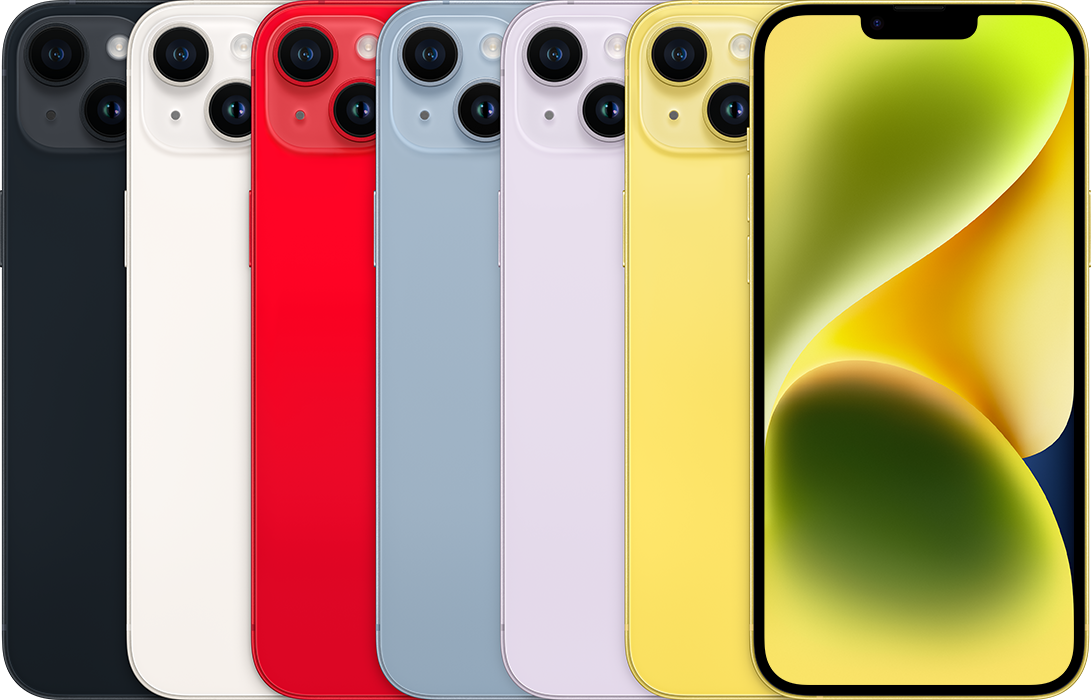
The iPhone 14 Plus marks the first time Apple has offered a 6.7-inch version of its standard iPhone. Released alongside the iPhone 14 in September 2022, the Plus model offers the biggest display ever on a non-Pro iPhone, complete with all-day battery life.
Key iPhone 14 Plus features and specifications:
- Display: 6.7-inch Super Retina XDR OLED display
- Chipset: A15 Bionic processor, 5-core GPU
- Camera: 12MP main and 12MP ultrawide cameras, Photonic Engine
- Video Recording: 4K video recording with Dolby Vision HDR
- Battery Life: Up to 26 hours video playback
- Storage: 128GB, 256GB, and 512GB capacities
- Design & Colors: Aluminum frame with ceramic shield front glass in colors like blue, purple, midnight, starlight, and red
- Safety Features: Crash detection and Emergency SOS via satellite
- Durability: Water resistant to a depth of 6 meters for 30 mins
- 5G Connectivity: Support for speedy 5G cellular networks
For those wanting longer battery life and a plus-sized display without paying for Pro-level prices, the iPhone 14 Plus fills that gap nicely while still delivering important camera and safety upgrades over previous generation iPhones.
2022 – iPhone 14 Pro

The iPhone 14 Pro represents the best-of-the-best camera, performance and display technology Apple has to offer. Launched in September 2022, the iPhone 14 Pro is defined by its visually striking Dynamic Island cutout and a class-leading 48MP main camera.
Key iPhone 14 Pro features and specifications:
- Display: 6.1″ Super Retina XDR display with ProMotion (1-120Hz adaptive refresh rate), up to 2000 nits peak outdoor brightness
- Dynamic Island: Distinctive pill-shaped cutout that blends into iOS to show alerts, activities and more
- Chipset: Faster A16 Bionic chip, 5-core GPU, enhanced Neural Engine performance
- Pro camera system: New 48MP main camera, 12MP ultrawide, 12MP telephoto with 3x optical zoom; Photonic Engine
- Video Recording: Up to 8K ProRes video recording
- Front Camera: Upgraded 12MP TrueDepth camera
- Battery Life: Up to 23 hours video playback
- Storage: Up to 1 TB storage
- Always-On Display: Glanceable lock screen content without tapping or lifting
- Durability Features: IP68 water resistance, Ceramic Shield front glass
Delivering always-on displays, a game-changing camera system and Apple’s most powerful chip ever in a smartphone, the iPhone 14 Pro sets a new standard.
2022 – iPhone 14 Pro Max

If you want the ultimate iPhone experience with no compromises on display size, performance or camera capabilities, the iPhone 14 Pro Max represents the state-of-the-art in Apple engineering. It combines pro-level technologies in areas like the camera, display, and chipset into an impressive 6.7-inch flagship device.
Standout iPhone 14 Pro Max features and specifications:
- Display: 6.7″ Super Retina XDR display with ProMotion, up to 2000 nits brightness
- Dynamic Island: Distinctive pill-shaped cutouts with fluid iOS integration
- Chipset: New A16 Bionic chip, 5-core GPU for graphics, enhanced Neural Engine for AI tasks
- Pro camera system: Upgraded 48MP main camera, 12MP telephoto 3x optical zoom, 12MP ultrawide camera with Photonic Engine
- Video Recording: Next-level 8K ProRes video recording
- Front Camera: Upgraded 12MP TrueDepth camera with autofocus
- Battery Life: Longest battery life ever in an iPhone, exceeding 29 hours video playback
- Storage: Up to massive 1TB storage
- Always-On Display: Customizable always-on lock screen content
- Durability: IP68 dust/water resistance, Ceramic Shield front glass
- 5G Connectivity: Works with latest 5G networks
If you want the pinnacle iPhone experience with no compromises on size, capability or performance, the iPhone 14 Pro Max is made for power users and creative pros who need the best.
2023 – iPhone 15

Apple’s iPhone 15 coming in 2023 may bring some of the most dramatic changes ever for the iPhone lineup. Early leaks point to several major upgrades on the way:
- Dynamic Island: The interactive pill-shaped cutout from iPhone 14 Pro models will expand to the standard iPhone 15, enabling convenient alerts.
- Design: Durable glass and aluminum physical design with water, splash and dust resistance. Features Ceramic Shield front glass.
- Display: 6.1” Super Retina XDR display speculated to reach up to 2000 nits brightness, up to 2X brighter than iPhone 14.
- Camera: Upgraded 48MP main camera for super-high resolution photos. Added 2x optical telephoto lens for quality close-up shots.
- Portrait Mode: Dramatically more portrait photo detail expected with subject isolation even after shooting.
- Performance: Next-gen A16 Bionic chip will power advanced iOS experiences like computational photography and fluid Dynamic Island activity. Long battery life.
The iPhone 15 in 2023 shapes up to drive Apple’s biggest iPhone redesign in years. Rumors point to Dynamic Island, a major camera overhaul with 48MP sensor, the lighting-fast A16 chipset, brighter displays and more durable build quality across the lineup. It could become Apple’s most feature-packed iPhone yet.
2023 – iPhone 15 Plus

The iPhone 15 Plus could bring a major upgrade in 2023 to those wanting a supersized iPhone experience. Early leaks suggest the iPhone 15 Plus will introduce Dynamic Island, camera upgrades, brighter displays and more:
- Dynamic Island: Interactive pill-shaped cutouts bubble up alerts, notifications and live activities conveniently.
- Design: Durable color glass back and aluminum frame. Water, splash and dust resistant with Ceramic Shield front glass.
- Display: Massive 6.7” Super Retina XDR display speculated to reach 2000 nits brightness, up to 2X brighter than iPhone 14 Plus.
- Camera: Rumored upgraded 48MP main camera for super detailed shots. Added 2x optical telephoto lens for quality close-ups.
- Portrait Mode: Significantly more portrait photo detail and post-capture subject isolation abilities tipped.
- Performance: Leaked A16 Bionic chip expected to enable advanced iOS experiences like computational photography and fluid Dynamic Island usage. Plus great battery life.
The iPhone 15 Plus could realize the ultimate big-screen iPhone experience for those wanting max displays. With Dynamic Island, 48MP camera, up to 2X brighter screen and faster A16 chip, it could outpace even the iPhone 14 Pro Max as Apple’s most powerful large iPhone yet.
2023 – iPhone 15 Pro

Apple’s iPhone 15 Pro coming in 2023 may represent the biggest iPhone overhaul in years with leaks pointing to a fresh titanium design, better cameras, next-gen processors and more:
- Design: Strong yet lightweight aerospace-grade titanium design for the first time. Textured matte glass back. Water, splash and dust resistant with Ceramic Shield front.
- Display: 6.1” Super Retina XDR display with up to 120Hz ProMotion refresh rates enabled by the A17 chip for fluid graphics. Also tipped to feature always-on display.
- Dynamic Island: Interactive pill-shaped cutouts bubble up alerts, notifications and live activities.
- Chipset: Rumored all-new A17 Pro chip will significantly boost gaming graphics and overall performance. Great efficiency for all-day battery.
- Cameras: Predicted upgraded 48MP main camera alongside telephoto, ultrawide and other lenses totaling 7 pro-level shooters. Super detailed photos.
- Action Button: Customizable button to instantly launch favorite iPhone actions like Camera, Shortcuts, Voice Memos.
Reliable analysts report the iPhone 15 Pro will drive Apple’s biggest ever iPhone overhaul in 2023 with radical changes to design, displays, cameras and performance. It could easily be the most feature-complete pro iPhone yet if early leaks hold true.
2023 – iPhone 15 Pro Max

If leaks hold true, the iPhone 15 Pro Max coming in 2023 could be Apple’s most feature-packed iPhone yet with a fresh titanium design, enhanced cameras, displays, performance and more:
- Design: Lightweight yet durable aerospace-grade titanium design tipped – a first for iPhone. Textured matte glass back Glass. Water, dust and splash resistant with Ceramic Shield front.
- Display: Massive 6.7” Super Retina XDR display with up to 120Hz ProMotion refresh rates enabled by the A17 chip for fluid graphics and motion. Always-on mode also rumored.
- Dynamic Island: Interactive pill-shaped cutouts to conveniently surface alerts, notifications and live activities.
- Chipset: Expected new A17 Pro chip should significantly elevate processing power and gaming graphics. Great power efficiency.
- Cameras: Upgraded 48MP main camera rumored alongside telephoto with 5x optical zoom, ultrawide and other pro lenses, totaling 7 shooters.
- Action Button: Customizable button to instantly trigger favorite iPhone actions like Camera, Shortcuts, or Voice Memos.
If leaks prove accurate, the iPhone 15 Pro Max could drive Apple’s most ambitious iPhone overhaul yet in 2023 with Titanium makeover, 48MP Pro camera system, pill-shaped Dynamic Island and next-gen Apple power under the hood.
Best iPhone for Gaming
Gaming requires maximum processing muscle and graphics capability for seamless gameplay. For power gamers, the iPhone XS Max takes the crown thanks to its blistering fast A12 Bionic chip which provides elite gaming performance even in 2023.
While newer iPhones like the 15 Pro match it for speed, the Max’s big 6.5” display gives you the most immersive gaming experience. The iPhone 11 Pro Max and iPhone 8 Plus also deserve shoutouts for their gaming prowess.
As for older models, the iPhone 3G and 3GS don’t make the cut for smooth modern gaming due to their single core processors. And surprisingly, the original iPhone has found a niche for gaming due to the challenge of its limited display and retro games.
Best iPhone for Photography
For photography enthusiasts, the current iPhone 15 Pro stands at the top as Apple’s most advanced computational camera system yet.
The new 48MP Main camera captures tremendous detail. Combined with the Ultra Wide and Telephoto lenses plus Apple’s image processing, it takes iPhone photography to the next level.
The iPhone 11 Pro also deserves high praise for kicking off Apple’s camera greatness with its versatile triple lens setup. And surprisingly, the original 2MP iPhone and 3G models have birthed their own lo-fi photography subcultures.
Best iPhone for Video Editing
If you’re into shooting and editing high-quality videos, the iPhone 15 Pro again rises to the top.
Its upgraded Cinematic mode records in 4K Dolby Vision with buttery smooth ProRes video possible. Night mode time-lapse photography also amazes.
For older models, the iPhone 11 Pro similarly excels at video with 4K 60fps capture and Extended Dynamic Range. And don’t forget the original iPhone revolutionized smartphone video.
Best iPhone for Battery Life
We use our iPhones for so much each day which can tax even robust batteries. For marathon battery life, the iPhone 14 Pro Max currently leads with up to 29 hours of video playback thanks to its great optimization.
The iPhone XR also holds legendary status for battery life, providing 1.5 hours longer runtime versus the iPhone XS Max despite a lower capacity battery. The original iPhone offers a measly 5 hours of audio with its 1400 mAh pack.
Best iPhone for Durability
From frequent drops to accidental water submersion, we put our iPhones through a lot. The most durable award goes to the iPhone 15 Pro which withstands drops from 4 meters thanks to its Ceramic Shield display and tough stainless steel design.
The iPhone 11 also gets kudos for surviving 6 meters underwater and over 100 rpm tumbling. At the other end, the all-glass iPhone 4 was far more fragile. But slapping a case on can protect any iPhone model when accidents strike.
Best iPhone on a Budget
If you want latest-generation iPhone capabilities on a budget, the iPhone SE 3rd Gen can’t be beaten. You get the same blazing A15 Bionic processor as the iPhone 14, great camera, water resistance, wireless charging, and more at an unbeatable value.
The iPhone 11, XR, and older Plus models are also solid buys used or refurbished. Just stay away from the short-lived iPhone 5C which looks cool but lacks features of similarly priced models.
Most Revolutionary iPhone Model
While every iPhone advanced Apple’s smartphone revolution, the original iPhone (2007) changed the game most significantly. It made multi-touch and apps usable at scale for the first time. Without it, the modern smartphone wouldn’t exist.
The iPhone X (2017) also deserves huge kudos for pioneering the all-screen design with Face ID that redefined the iPhone. And let’s not forget the iPhone 3G which brought the App Store ecosystem in 2008 that became central to the experience.
Best Overall Value iPhone
Balancing price, feature set, and longevity, the sweet spot winner is the iPhone 11. It delivers a flagship quality experience. The A13 processor still rocks, battery life is killer, and the dual camera with Night mode competes with latest phones. Unless you need 5G, it’s an incredible value buy.
The iPhone XR also stands out for ushering in features like Face ID and the edge-to-edge display. And the used iPhone 8 Plus packs OLED quality and dual cameras for under $200 now.
Worst iPhone Models to Avoid
Every iPhone has merits, but a few are poorer values or quickly became outdated:
- iPhone 5C – Plastic design lacked premium feel, and specs weren’t much better than the prior iPhone 5.
- Original iPhone – Revolutionary for 2007 but 3G networking, GPS, and the App Store changed everything.
- iPhone 3GS – Added key features like video recording but design unchanged from 3G wasn’t very exciting even in 2009.
- iPhone XS – With virtually no improvements over the X besides a faster chip, it was a tough $999 sell.
- iPhone 6 – Bendgate and contact issues plagued the 6. And the Plus model was simply better.
How to Choose the Right iPhone for You
With so many models and features to consider, selecting your next iPhone can be challenging. Here are some tips for making the right choice:
- For an affordable powerhouse, go for the iPhone SE 3rd Gen or used/refurb 11.
- If you want best-in-class battery life, the 15 Pro Max is unbeatable.
- Photography buffs should spring for the latest iPhone Pro model available.
- Gamers need to maximize power – go for the XS Max or 11 Pro Max.
- Frequent droppers/splashers should seek out models with durability like the iPhone 14 Pro.
- If keeping costs low is critical, an older generation like the iPhone 7, 8 or first SE are still solid.
Think about which features and capabilities matter most to you. Then find an iPhone generation that delivers those strengths while fitting into your budget.
Accessories to Enhance Your iPhone
You can further augment your iPhone’s functionality and protection with these handy accessories:
- Cases: OtterBox, Spigen, and LifeProof make durable cases to guard against drops.
- Screen Protectors: Tempered glass protectors by ZAGG maintain touch responsiveness while preventing scratches.
- Charging: Anker makes fast chargers to juice up quickly. Portable batteries from Mophie provide on-the-go power.
- Cables: Braided cables stand up to fraying. Magnetic connectors like Anker’s snap into place easily.
- Speakers: For room-filling sound, the Bose SoundLink Micro pumps out surprisingly big bass.
- Tripods & Gimbals: Joby and Zhiyun accessories let you shoot pro-level steady video.
- Lenses: Moment lenses like macro and wide-angle attach magnetically for next-level mobile photography.
Accessorizing expands your iPhone’s capabilities for work and play. Protect it with durable gear and enhance audio, photography, charging or other functions with must-have add-ons tailored to your needs.
Maintaining and Repairing Your iPhone
To keep your iPhone performing like new for years to come, incorporate these maintenance practices:
- Update to the latest iOS version to keep your iPhone secure and provide new features.
- Use a case and screen protector to prevent damage from inevitable drops.
- Don’t charge beyond 100% or let the battery fully deplete for maximum battery lifespan.
- Clean the charging port to prevent pocket lint buildup that can block charging.
- Turn on Auto-Lock and reduce screen brightness to conserve battery power.
- Free up space when your iPhone storage feels sluggish.
For DIY repairs, iFixit provides detailed guides and replacement parts. Apple also offers flat rate iPhone battery and screen replacements to restore performance.
Helpful Hidden Features in iOS
iOS is packed with helpful hidden features beneath the surface:
- Tap and hold the space bar to move the cursor when typing.
- Swipe left/right on the home bar for quick app switching.
- Tap top of screen to quickly scroll to the top.
- Triple-click Home button for accessibility features like color filters.
- Press volume up then down in quick succession to take a screenshot.
- Hold side button and volume up to temporarily disable Face ID.
Dig into Settings and play around with your iPhone to uncover powerful features Apple doesn’t advertise.
The Evolution of the iPhone Continues
From its status-changing debut in 2007 to 2023’s photographic powerhouse iPhone 14 Pro models, the iPhone has constantly revolutionized personal technology over the past 15+ years.
Apple continues innovating with exciting rumors of an all-new portless design and expanded functionality on tap for the iPhone 15. But you can find fantastic value right now on older models like the iPhone 11 that deliver fast performance at bargain prices.
Hopefully, this chronological guide to every iPhone generation has provided you with a fun look back and great insight for picking your next upgrade. The possibilities are endless thanks to Apple’s ever-advancing iPhone lineup.
